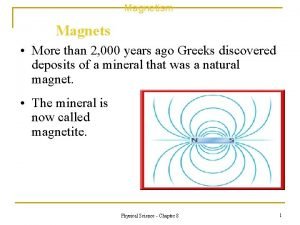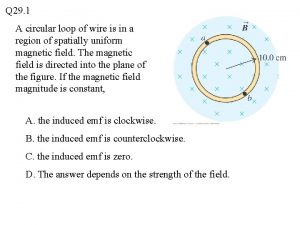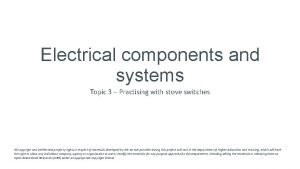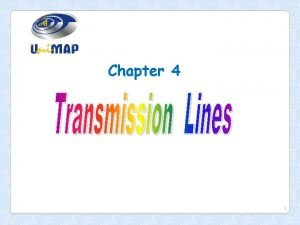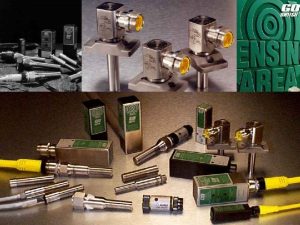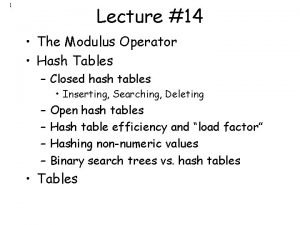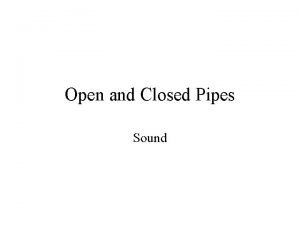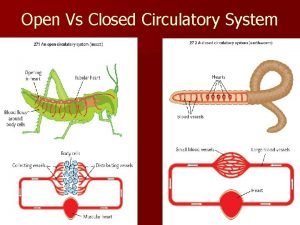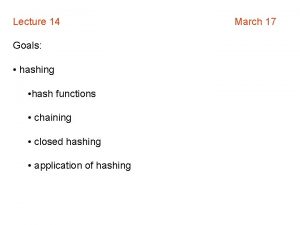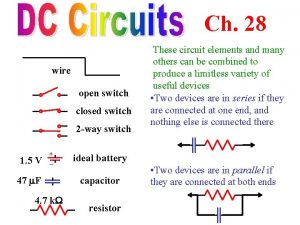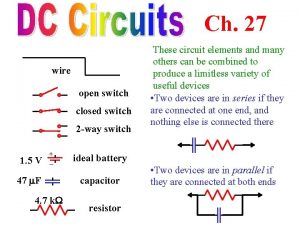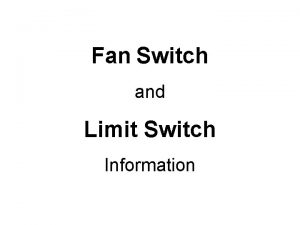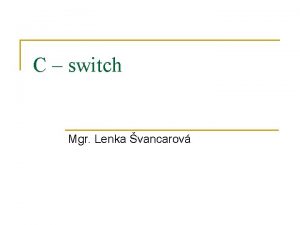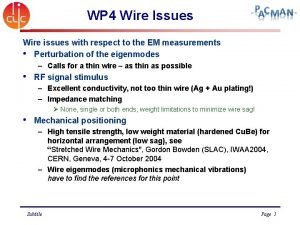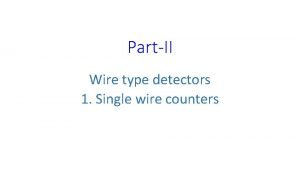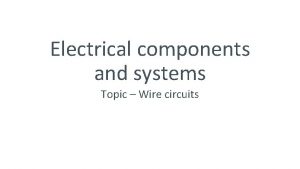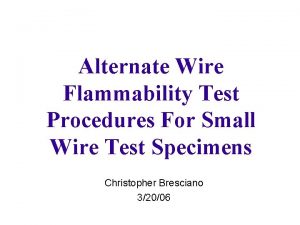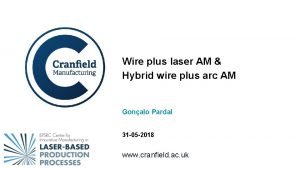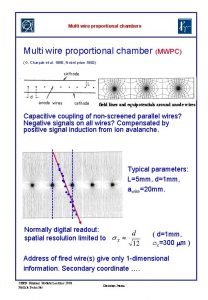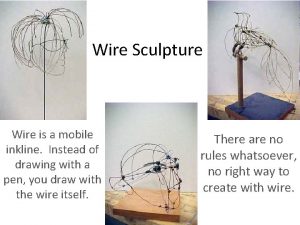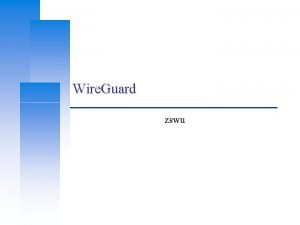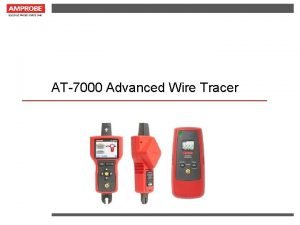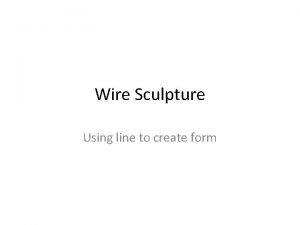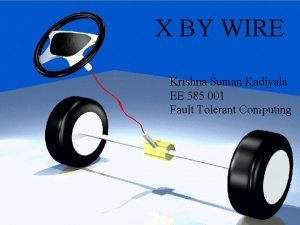Ch 27 wire open switch closed switch 2
































- Slides: 32

Ch. 27 wire open switch closed switch 2 -way switch 1. 5 V + – 47 F 4. 7 k These circuit elements and many others can be combined to produce a limitless variety of useful devices • Two devices are in series if they are connected at one end, and nothing else is connected there ideal battery capacitor resistor • Two devices are in parallel if they are connected at both ends

Resistors in Parallel and in Series • When resistors are in series, the same current must go through both of them • The total voltage difference is R 1 R 2 • The two resistors act like one with resistance • When resistors are in parallel, the same potential is across both of them • The total current through them is • The two resistors act like one with resistance R 1 R 2

Warmup 10 c

Parallel and Series - Formulas Capacitor Series Parallel Fundamental Formula * To be defined in a later chapter Resistor Inductor*

The Voltage Divider • Many circuits can be thought of as a voltage divider • Intentionally or unintentionally What’s the voltage drop across each of the resistors? R 1 + – E R 2 The larger resistor gets most of the voltage 120 V + – If Mr. Curious has a resistance of 10 k and the light bulb has a resistance of 240 , how bright is Mr. Curious? Not very bright

Ans A Ans C

Ans C

Ans A

Quick Quiz 27. 2 With the switch in the circuit of the top figure closed, there is no current in R 2 because the current has an alternate zero-resistance path through the switch. There is current in R 1, and this current is measured with the ammeter (a device for measuring current) at the bottom of the circuit. If the switch is opened (the bottom figure), there is current in R 2. What happens to the reading on the ammeter when the switch is opened? (a) The reading goes up. (b) The reading goes down. (c) The reading does not change. Ans b

Quick Quiz 27. 3 With the switch in the circuit of the top figure is open, there is no current in R 2. There is current in R 1, however, and it is measured with the ammeter at the right side of the circuit. If the switch is closed (the bottom figure), there is current in R 2. What happens to the reading on the ammeter when the switch is closed? (a) The reading increases. (b) The reading decreases. (c) The reading does not change. Ans a

Which resistors are in series and which are in parallel

Solve on Board

Warmup 10 c

Ideal vs. Non-Ideal Batteries + – – + – 50 + • Up until now, we’ve treated a battery E as if it produced a fixed voltage, no matter what we demand of it ideal battery • Real batteries also have resistance r E • It limits the current and therefore realistic battery the power that can be delivered • If the internal resistance r is small The maximum potential compared to other resistances in the difference E across the problem, we can ignore it battery is called 10 30 V electromotive force (emf) A 30 V battery with 10 of resistance is connected to a 50 resistor. What is the actual voltage across the 50 resistor? A) 30 V B) 36 V C) 6 V D) 25 V E) 24 V

Quick Quiz 27. 4 Part I In the figure, a third resistor is added in series with the first two. What happens to the current in the battery? (a) increases, (b) decreases, (c) remains the same. Ans b

Quick Quiz 27. 4 Part II What happens to the terminal voltage of the battery? (a) increases, (b) decreases, (c) remains the same. Ans a

Kirchoff’s First Law The total current into any vertex equals the current out of that vertex 12 V – + Which equation do you get for point A? A) I 1 + I 2 = I 3 B) I 2 + I 3 = I 1 C) I 1 + I 3 = I 2 D) I 1 + I 2 + I 3 = 0 • The equation from point B is You always get one redundant equation – A 6 V + I 2 B I 1 3 How to apply it: • First, assign a current and a direction to every pathway • Two components in series will always have the same current • At every vertex, write the equation: 5 4 I 3

Kirchoff’s Second Law The total voltage change around a loop is always zero 12 V – + I 1 3 I 2 + How to apply it: • First, assign a direction to every loop • I often pick clockwise • Start anywhere, and set 0 equal to sum of potential change from each piece: • For batteries: V = E • It is an increase if you go from – to + • It is a decrease if you go from + to – • For resistors: V = IR • It is a decrease if you go with the current • It is an increase if you go against the current – 5 6 V 4 I 3

Kirchoff’s Second Law (2) 12 V – + I 1 3 What is Kirchoff’s Second Law for the purple loop? A) 0 = +5 I 2 – 6 – 4 I 3 B) 0 = +5 I 2 + 6 – 4 I 3 C) 0 = – 5 I 2 – 6 – 4 I 3 D) 0 = – 5 I 2 + 6 – 4 I 3 + I 2 Three equations in three unknowns: solve it • We can let Maple do it for us > solve({i 3=i 1+i 2, 0=-5*i 2 -6 -4*i 3, 0=18 -3*i 1+5*i 2}, [i 1, i 2, i 3]); Negative currents means we guessed the wrong way • Not a problem – 5 6 V 4 I 3

Solve on Board

Kirchoff’s Laws with Capacitors. I If know which side is positive then that is high potential – work like battery. • The voltage change is given by V = Q/C • It is a decrease if (+)Q is the side you are going in + • It is an increase if Q is the side you are going out – • The current is related to the time change of Q • Add minus sign if I doesn’t enter from the same side as Q – it is minus if decreasing • If you are in a steady state, the current through a capacitor is always zero Q C In this circuit, in the steady state, where is current flowing? + – It’s really just a battery and two resistors in series!

The Simplest RC Circuit Q 0 C R I In the circuit shown at left, the capacitor starts with charge Q 0. At time t = 0, the switch is closed. What happens to the charge Q? • Current begins to flow around the loop, so the charge Q will change • This is a differential equation, and therefore hard to solve Check the units:

Charging and Discharging Capacitors • The combination RC = is called the time constant • It’s the characteristic time it takes to discharge • We can work out the current from Q C I R + – E In this circuit, the capacitor is initially uncharged, but at t = 0 the switch is closed


Ans A

Quick Quiz 27. 5 Part I Consider the circuit in the figure and assume the battery has no internal resistance. Just after the switch is closed, what is the current in the battery? (a) 0 (b) /2 R (c) 2 /R (d) /R (e) impossible to determine Ans c

Quick Quiz 27. 5 Part II After a very long time, what is the current in the battery? (a) 0 (b) /2 R (c) 2 /R (d) /R (e) impossible to determine Ans d

Solve on Board

Ammeters and Voltmeters • An ammeter is a device that measures the current (amps) anywhere in a circuit A • To use it, you must route the current through it • A perfect ammeter should have zero resistance • A voltmeter is a device that measures the potential difference (volts) between any two points in a circuit V • To use it, you can simply connect to any two points • A perfect voltmeter has infinite resistance A Which meter is installed incorrectly? A) Left voltmeter B) Right voltmeter + V A C) Left ammeter D) Right ammeter – E) All are correct V • Voltmeters should be connected to two places in an existing circuit • The left voltmeter is placed correctly • A voltmeter has infinite resistance • The right one effectively blocks the current on the right

Household Wiring *Actually, this is alternating current, later chapter • All household appliances consume electrical power • Think of them as resistors with fixed resistance R • Devices are designed to operate at 120 V* • Often, they give the wattage at this voltage • Can easily get the effective resistance from • To make sure power is given to each device, they are all placed in parallel Fuse A + box – Inside House • If you put too many things on at once, a lot of current is drawn • The wires, which have some resistance, will start to get hot • To avoid setting the house on fire, add a fuse (or a circuit breaker)

Warmup 11

Why three wires? • If a device is functioning properly, you need only two wires • “Live” and “Neutral” wires Toaster • If the live wire accidentally touches the casing, the person can be electrocuted • The wrong solution – connect the neutral to the casing • Now imagine the neutral wire breaks • The person again can be electrocuted • The right solution: Add a third “ground” wire connected directly to ground • Normally no current will flow in this wire • If the hot wire touches the casing, it will trigger the fuse/circuit breaker and protect the person
 Open and closed switch
Open and closed switch Why do magnets repel
Why do magnets repel A circular loop of wire is in a region of spatially uniform
A circular loop of wire is in a region of spatially uniform On delay and off delay timer symbol
On delay and off delay timer symbol Open innovation open science open to the world
Open innovation open science open to the world Contin
Contin Line
Line In a banyan switch micro switch
In a banyan switch micro switch Go switch limit switch
Go switch limit switch Is earth an open or closed system
Is earth an open or closed system Mhd generator ppt
Mhd generator ppt Modulus function c++
Modulus function c++ What is a closed thesis statement
What is a closed thesis statement Pipe resonance
Pipe resonance Open impeller vs closed impeller
Open impeller vs closed impeller Graph open circle
Graph open circle Skill acquisition continuum
Skill acquisition continuum Rangkaian clipper
Rangkaian clipper Difference between open and closed questions
Difference between open and closed questions Open and closed skills examples
Open and closed skills examples Closed and open figures
Closed and open figures Open instruments
Open instruments Open air refrigeration system
Open air refrigeration system Is less than open or closed circle
Is less than open or closed circle Open and closed stratification systems
Open and closed stratification systems Difference between open cycle and closed cycle gas turbine
Difference between open cycle and closed cycle gas turbine Arteries and veins difference
Arteries and veins difference Wendy cope lonely hearts
Wendy cope lonely hearts Highly closed question
Highly closed question Motor decussation in medulla
Motor decussation in medulla Is less than open or closed circle
Is less than open or closed circle Open loop vs closed loop in cars
Open loop vs closed loop in cars Open and closed hashing
Open and closed hashing

